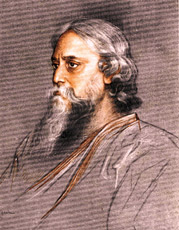Tagore's contribution to creative dance form
by Subashini PATHMANATHAN
Rabindranath Tagore's contribution to dance is entirely different
from the traditional dance form and folk dance forms of India . The
dance form was entirely different from the dance forms of his time. He
introduced his own creative dance forms to the dance world. Tagore felt
that a dance form should be a living art, must be simple and must not be
affected by the rhythm, but it must have a natural flow.
The sense of rhythm reflected in Tagore's dance is very simple and
graceful and gentle. According to Tagore, man's first creation of rhythm
was experienced in his body itself, the dance was also performed by him
initially only to express the grace of his body movements without any
other greater purpose and only for the joy of rhythm'.
 |
|
Rabindranath Tagore |
Tagore's dance could be analyzed in two different ways. Some regarded
Tagore's dance as a style. Some others considered it Tagore's dance
concept. One must have a style of a dance which means it must have a
structure, formation, and firm type of execution.
The concept of dance must be influenced by various aspects. Hence
Tagore's creative dance form can be considered as a concept of dance
form and cannot be considered a style of dance form. But many art
critics always considered that Tagore's creative dance is a style of
dance form. Tagore himself was not only a poet, philosopher, painter,
choreographer of dance and drama but also a dance teacher.
His imaginative creativity could be found in all of his art works
including dance, drama, music, and poetry. One must understand that
during his period dance was not much recognized in the society. Many
artists were dominating the Bengali theatre and art scene in Bengal .
Tagore recognized that art was a vehicle for education.
According to the available data Tagore established Shantiniketan at
the end of 1901. At that time most of the students joined Shanthiniketan
which belonged to the middle class families. During the time nobody was
interested in learning dance as a part of general education. But Tagore
introduced the fine arts such as dance, drama, music, and painting as a
part of education, from the inception of Shanthiniketan.
But at the initial stage it was not possible for him to impart or
provide proper dance faculty. In the year 1878, he went abroad, and got
an opportunity to witness the western ballet. That influenced his mind
and introduced certain techniques based on this basis to his creative
dance form. He encouraged the students to study and continue the dance
for songs in the plays.
First he used dance in the play 'Manamoiyee' in 1880. He himself
played the role as a dance teacher, and choreographer. He himself
composed a series of dances based on western ballets. He choreographed a
dance for 'Aay Aay Sahachari', again in 1899; he produced another play 'Punarbasantha'
in which he used the same song for the dance.
He composed some songs and danced for the songs himself. Even in
these plays he himself danced.
His beautiful methodology of dance influenced the young minds. Yet
there was no proper faculty to impart dance at his institution. In 1919
Guru Buddhimanta Singh was invited to teach Manipuri dance in
Santhiniketan.
In 1923 in a play named Vasantha, Tagore and so many others
participated in this play. Mainly they participated and danced rhythmic
movements. In 1924 a group of students from Sourasta danced at
Santhiniketan which very much impressed Tagore.
Different gurus came to Shantiniketan to study the special dance
form. Some of the ballets produced by Santhiniketan such as 'Chandalika',
and 'Chitranga', were the best examples for the different combined
styles of Indian dance forms. Thus was born in Tagore's imaginative
creativity.
|

